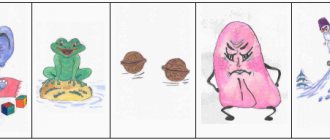The interaction of the speech therapist with the group teachers is a very important point, because teachers spend a lot of time with children and can help a child with speech disorders. They can include speech therapy exercises in games, monitor the purity of speech and correct sound pronunciation during a walk, in class, during a morning appointment, but they lack knowledge in this area.
Constant interaction between a speech therapist and teachers is necessary for the formation of correct speech skills in children with speech pathology and brings excellent results. In addition, joint work is also necessary because eliminating speech defects requires an integrated approach, since speech disorders are associated with a number of reasons, both biological and social. An integrated approach to overcoming speech impairment involves a combination of correctional pedagogical and therapeutic work, and this requires the interaction of a speech therapist and a teacher.
Tasks of joint work between a speech therapist and educators
- Together, find the best options for working with a specific group and with each child individually, agree on the organization, conduct of classes, and their content.
- Arrange classes so that the speech therapist does not duplicate the tasks that the teacher gives to the children, and vice versa.
- Teach children correct sound pronunciation, perception and reproduction of words. Teach them to maintain the correct pace and rhythm of speech (not to chatter, but also not to speak too slowly).
- Expand the vocabulary of preschoolers.
- Help children study the process of word formation and grammatical structure. It is recommended to correct grammatical errors in speech not only in class, but also during walks, games, etc.
- Develop higher mental functions: thinking, imagination, attention, memory. Form coherent speech among students.
- Develop fine and articulatory motor skills in children.
Peculiarities of interaction between a speech therapist and a teacher at a pre-school speech center
Peculiarities of interaction between a speech therapist and preschool teachers at a speech center.
Federal state educational standards indicate the need to integrate educational areas and the educational process as a whole. Naturally, this is also necessary in correctional and developmental work. In relation to the correction of speech disorders, the integration process involves the creation of a subject-developmental environment that stimulates the child’s personal and speech development, the professional growth of teachers, their close interaction with parents, and the process of correctional and developmental activities itself.
Currently, almost every preschool educational institution has logo centers. First of all, this is due to a decrease in the level of speech development of preschool children. Modern mastery of correct speech is of great importance for the formation of a full-fledged personality of a child and successful learning at school. Most authors (R.E. Levina, A.V. Yastrebova and others) associate schoolchildren’s poor performance in the Russian language, first of all, with the level of speech underdevelopment.
Due to the tendency for the speech of children in preschool age to deteriorate and the lack of speech therapy kindergartens in our city, children with more severe speech disorders began to be admitted to our preschool institution.
The work of a speech therapist in an educational institution, in its structure and functional responsibilities, differs significantly from the work of a speech therapist in a speech kindergarten. This is primarily due to the fact that the speech therapist at the speech center is integrated into the general educational process, and does not go alongside it, as is customary in speech kindergartens. The work of a speech therapist is based on the internal schedule of the preschool educational institution.
The main tasks of a speech therapist teacher at a speech center are:
- Formation and development of phonemic hearing in children with speech disorders;
- Correction of disorders of sound perception and sound pronunciation;
- Timely prevention and overcoming difficulties in speech development;
- Instilling communication skills in children;
- Solving problems of social and speech development;
The speech therapist is forced to intervene in the learning process on the day the child attends his classes. Children with speech disorders themselves receive correctional assistance in portions, and not daily, like children in the speech therapy group. It is also necessary to remember that the child must attend all preschool classes. From work experience, I concluded that it is necessary to pick up the child either before the lesson or closer to the end, so that he has time to learn the group material.
Thus, the need arose for close interaction and mutual assistance between the speech therapist and teachers of the age group whose children attend speech therapy classes. In this union, the speech therapist acts as the organizer and coordinator of correctional work; it is he who provides maximum speech therapy assistance. And the teacher, in turn, communicates with children daily and for quite a long time, knows their interests and capabilities, and therefore can determine the optimal forms of including the necessary tasks of a correctional and developmental orientation.
To achieve optimal results of correctional work, we have developed
Forms of interaction with teachers
1. The search for new forms and methods of working with children with speech pathologies led us to the question of planning and organizing clear, coordinated work of a speech therapist and teachers in the conditions of a municipal preschool educational institution.
2. In the morning we meet with teachers and begin to exchange information on the results of the work done over the past day, discuss the children’s achievements, and identify difficulties that have arisen.
3. We pay special attention to speech therapy warm-ups developed by speech therapists at our kindergarten, where the teacher trains children in proper speech breathing, a sense of rhythm and expressiveness of speech, works on the prosodic side of speech, develops the articulatory apparatus and fine motor skills.
4. We consider one of the conditions for improving the quality of correctional work to be the teacher conducting a speech hour using the interaction notebook, therefore, every day we discuss tasks developed by the speech therapist for each child, which include:
- exercises for automation and differentiation of delivered sounds, and control over them;
- lexical and grammatical tasks and exercises for the development of coherent speech.
5. The use of various forms of communication helps organize joint activities and improve the professional skills of teachers: personal contacts, practical seminars, open screenings, methodological gatherings, business games, joint discussions of new teaching and scientific literature.
It is necessary that all adults surrounding the child clearly understand the purpose of their activities, which consists, on the one hand, in the full development of a child with speech development disorders, and on the other, in coordinated interaction with each other.
6. The independent activity of the teacher is important, where he monitors the state of children’s speech activity in each period of the correctional process: conducts a speech hour, organizes outdoor and role-playing games, not forgetting to control the correct use of sounds set or corrected by the speech therapist.
I provide consultations and workshops for teachers on:
• rules and conditions for conducting articulation gymnastics
• the need for daily exercise
• individual work with subgroups of children with the same defects
• automation of already delivered sounds (pronunciation of syllables, words, phrases, memorization of poems)
• control of children’s pronunciation of already assigned sounds during routine moments
The work of a teacher and the work of a speech therapist differs in the correction and formation of sound pronunciation in terms of organization, techniques, and duration. It requires various knowledge, skills and abilities. The main difference: a speech therapist corrects speech disorders, and a teacher, under the guidance of a speech therapist, actively participates in correctional work.
The teacher actively participates in the correction process, helping to eliminate the speech defect and normalize the psyche of the problem child as a whole. In his work, he is guided by general didactic principles, while some of them are filled with new content. These are the principles of systematicity and consistency, the principle of an individual approach.
The principle of systematicity and consistency involves adapting the content, methods and techniques of the teacher’s activities to the requirements imposed by the tasks of a specific stage of speech therapy. The gradualism in the work of a speech therapist is determined by the idea of speech as a system, the assimilation of elements of which occurs interconnectedly and in a certain sequence.
Taking into account the sequence of mastering these aspects of speech in speech therapy classes, the teacher selects for his classes speech material that is accessible to children, which contains sounds that they have already mastered and, if possible, excludes those that have not yet been studied. When automating sounds, we used the leading activity of a preschool child - a game, namely a didactic game, which is a multifaceted, complex process; it is a gaming method of teaching, and a form of learning, and an independent activity, and a means of comprehensive personal development. Educational material that is presented to a child in a game is absorbed faster, easier and gives better results.
The teacher can build individual work in the classroom taking into account the speech problems of each child. So, knowing that the child’s sound [c] is at the stage of automation, the teacher can include tasks with this sound, even minimally, in all group lessons. For example, in a math class, suggest counting objects that have this sound in their names.
In a lesson to prepare for mastering literacy, each child is asked to parse words with those sounds that they are currently correcting with a speech therapist.
Lexico-grammatical tasks are aimed at repeating the material covered by a speech therapist. This allows the teacher to once again identify the child’s problems and help overcome them. During free play time, the teacher invites the child not to just play a didactic game, but to play a game that corresponds to the lexical speech therapy topic. (“Mothers and Babies”, “On the contrary”)
Improvement of a coherent statement takes place in the formation of a complete answer in classes on composing stories and descriptions on a lexical topic. In games and exercises “I am a storyteller”, “We will not show, but tell.”
In the afternoon, the teacher can also invite children to practice fine motor skills: “Collect beads”, “Lay out a drawing”, “Caps”, shading, modeling, cutting out. Thus, not only is the group working on the general tasks of preparing the hand for writing, but also correctional work is being carried out on the interaction of fine motor skills and the articulatory apparatus.
The work of a teacher and the work of a speech therapist differs in the correction and formation of sound pronunciation in terms of organization, techniques, and duration. The main difference: a speech therapist corrects speech disorders, and a teacher, under the guidance of a speech therapist, actively participates in correctional work and consolidates the knowledge acquired by children.
The teacher actively participates in the correction process, helping to eliminate the speech defect and normalize the psyche of the problem child as a whole.
The teacher regularly monitors the dynamics of sound pronunciation for all children in the group or for a specific child. Based on the results of his observations, the teacher offers the child only the speech material that he can handle. It becomes easier for the teacher to choose poems for the holiday (in case of difficulties, a speech therapist helps). Fewer problems arise in classes: the teacher knows what answers he can expect from the child and does not seek to demand impossible efforts from the latter. Thus, the child is not provoked into fear of answering in class; the incorrect pronunciation of those sounds that he is not yet capable of is not consolidated.
When selecting speech material, the teacher is called upon to remember the speech problems of each child. But he does not always have the opportunity to track those moments that may interfere with the work on the correct consolidation of speech material. The popular methodological literature does not always contain suitable tongue twisters, tongue twisters, and poems. A good example: the pure saying “To the court - to the court - to the court - Larisa washed the dishes.” It cannot be used to automate the sound [S] if the child does not have the sounds [L and R]. The teacher may not know about this if he focuses only on the sound [S]. In this case, the teacher himself or with the help of a speech therapist remakes it (“Sudu-sudu-sudu-I will wash the dishes” or “Sudu-sudu-sudu-mom will wash the dishes”).
The speech therapist teacher helps the teacher select speech material that corresponds to the norm of sound pronunciation of children with speech disorders. Recommends that the teacher work with ready-made printed publications, advises using methodological and children's fiction and speech material that is correct from a speech therapy position.
All the teacher’s activities, didactic games, and routine moments are used to train children in accessible independent speech. The basis for this work are the skills acquired by children in correctional and speech therapy classes. During the day, the teacher organizes such routine moments in the group as washing, dressing, eating, and at the same time trains children in short or detailed answers to questions (depending on the stage of correctional speech therapy work and the child’s individual speech capabilities). Morning and evening walks strengthen the physical condition of children and ensure proper sleep.
The correct organization of the children's team, the clear implementation of routine moments have a positive effect on the physical and mental state of the child and, consequently, on the state of his speech. The ability to correctly approach each individual child, taking into account his individual psychological characteristics, pedagogical tact, calm, friendly tone - these are the qualities that a teacher needs when working with children with speech disorders.
One of the successful forms is a notebook of interaction between a speech therapist and teachers. Its use helps to carry out corrective work in the morning and evening hours. The contents of the notebook include: gaming techniques aimed at developing the articulatory apparatus, speech breathing, coordination of general motor movements and fine motor skills of the fingers; recommendations for automating sounds in children; a list of tasks and exercises aimed at developing cognitive processes, lexical-grammatical structure and coherent speech in accordance with the lexical topic. At the end of the week, the group’s teachers discuss the results of the week’s work at a round table. It is important that the teacher and speech therapist simultaneously solve both correctional and educational and general developmental problems.
Thus, a coordinated approach to the general and speech education of children when organizing games, classes, recreational activities and other activities, the development of uniform pedagogical guidelines in relation to individual children and the group as a whole become the basis of interaction, which is what our team strives for. Only in close cooperation of all participants in the correctional educational process is it possible to successfully develop the personal readiness of children with speech impairments for school education. Experience shows that graduates of our kindergarten adapt to school conditions much more easily, are the most sociable, adequately evaluate their activities, are able to overcome emerging difficulties, do not experience fear of public speaking, and are the most successful in learning.
What is the interaction between a speech therapist and educators?
- Carrying out work by educators prior to speech therapy classes to accumulate, expand, and activate the vocabulary, providing the necessary cognitive and motivational basis for the formation of speech skills.
- Conducting systematic exercises to develop breathing, articulation, fine and gross motor skills.
- When planning and conducting educational activities in mathematics, cognitive development, artistic and creative activities, integrate speech therapy goals.
- Creating conditions in the group that promote the activation of children’s speech.
- Systematically monitor children’s speech not only during educational activities, but also in special moments.
- Explain (if necessary) the tasks of the speech therapist to parents to consolidate the material covered during home activities, which include replenishment, clarification, activation of the dictionary, consolidation of correct sound pronunciation, development of fine and articulatory motor skills.
And in conclusion, I would like to say that it is the joint work of the speech therapist and educator that will give positive dynamics in the speech development of each preschool student.
Consultation progress
- Introductory conversation.
One of the brightest trends in the modernization of education is the provision of state guarantees of accessibility and equal opportunities for children with disabilities to receive a full education. Thus, children with speech development disorders should receive timely and qualified correctional and speech therapy assistance in preschool settings. At the same time, the problem of finding effective ways to correct speech is becoming increasingly important.
Only with close cooperation and unity of the requirements of specialists is it possible to overcome the speech development disorders that children have. Collaboration between a speech therapist and preschool teachers plays a special role in the speech therapy group.
- Principles and features of organizing joint activities of a speech therapist teacher and a preschool educational institution logotype teacher.
The joint activities of a speech therapist and preschool educators are organized in accordance with the following goals:
- increasing the effectiveness of correctional and speech therapy work;
- rational distribution of speech therapist and educators’ activities during the day to avoid overloading children;
- adequate selection of forms, methods, techniques and means of correctional pedagogical activities of the speech therapist and educators, aimed at both the entire group of children and an individual child.
The main types of organization of joint activities of a speech therapist and educators:
- joint study of the content of preschool educational institutions programs and drawing up a joint work plan;
- open classes with a speech therapist teacher to familiarize educators with basic teaching techniques, the selection of visual and speech material, as well as the requirements for children’s speech;
- discussion of the results of joint work with children, which was carried out in and outside the classroom;
- joint preparation for children's parties;
- development of general recommendations for parents.
Functions of a speech therapist and educator in the development of speech components of preschool children and non-speech mental processes associated with speech
Table 1.
| Functions of a speech therapist | Functions of a teacher |
| Development of the phonetic component of the language system. | Improving speech breathing, articulation and fine manual motor skills of children. Constant control over the correct pronunciation of the given sounds. |
| Formation of phonemic processes. | Taking into account the lexical topic chosen by the speech therapist during all group classes during the week. |
| Improving the state of the lexical component of speech. | Incorporation of practiced grammatical structures into situations of natural communication in children. |
| Development of the word formation process of nouns, adjectives, verbs. | Formation of coherent speech. |
| Formation of the grammatical structure of speech. | Strengthening graphomotor skills. |
| Improving coherent speech. | Development of attention, memory, verbal-logical thinking, imagination in game exercises on defect-free speech material. |
| Improving graphomotor skills and introducing children to the basics of literacy. | |
| Development of non-speech mental functions closely related to speech: verbal-logical thinking, memory, attention, imagination. |
Educators carry out the tasks of the speech therapist every day, using individual, subgroup and frontal forms of work, as well as routine moments.
Educators should know:
- main directions of the correctional program;
- age-related and individual characteristics of speech formation in preschoolers;
- features of the pronunciation and lexico-grammatical aspects of speech and take into account the speech capabilities of each child in the process of educational and extracurricular activities.
Educators must comply with the conditions for the development of speech activity and verbal communication of children:
- organize and support children’s verbal communication in class and outside of class;
- encourage you to listen carefully to other children;
- develop skills of self-control and critical attitude to speech;
- organize games to develop the sound culture of speech;
- carry out work on the development of auditory and speech attention.
Speech therapy group teachers should not:
- rush the child to answer;
- interrupt speech and rudely pull it back, but should tactfully give an example of correct speech;
- force the child to pronounce a phrase rich in sounds he has not yet identified;
- let memorize texts and poems that the child cannot yet pronounce.
It is recommended to allocate a place in the group for speech therapy classes, the so-called speech therapy corner, in which there should be board-printed games for the formation of the correct air flow, the development of non-speech processes, in the joint activity of an adult with children, in the free independent activity of children.
The speech therapist, together with preschool teachers, designs the parent corner, prepares and conducts parent meetings.
- Conclusion.
Correct, pedagogically justified interaction between educators and a speech therapist, combining their efforts in the interests of speech correction in children, is based on the creation of a friendly, emotionally positive environment in a speech therapy group.
Speech development is decisive in the level of human intelligence and culture. Correct, literate speech shows whether children are ready for school and whether they can successfully master literacy and reading.
Properly planned lessons of the teacher and speech therapist ensure the correct consolidation of the material in various types of children’s activities. Such interaction creates a unified correctional and developmental environment around the child.
The psychological atmosphere in the children's team strengthens children's faith in their own capabilities, allows them to smooth out negative experiences associated with speech impairment, and develop interest in classes.
Properly organized psychological and pedagogical influence of educators in most cases prevents the appearance of persistent unwanted deviations in behavior and forms collective friendly, socially acceptable relationships in the speech therapy group.
Literature
- Ivanova O.F. Ways to optimize the joint work of a speech therapist and educator // Scientific and methodological journal Speech therapist, 2009, No. 3
- Karpova S.I., Mamaeva V.V., Nikitina A.V. Interaction in the work of speech group specialists // Speech therapist in kindergarten, 2007, No. 9 (24).
- Konovalenko V.V. Individual and subgroup work on correcting sound pronunciation. – M.: GNOM Publishing House, 2016. – 216 p.
- Morozova V.V. Interaction of a speech therapist with teachers of preschool educational organizations. – SPb.: PUBLISHING HOUSE “CHILDHOOD-PRESS” LLC, 2014. – 96 p.
- Smirnova L.N. The relationship in the work of a speech therapist and a teacher / Scientific and methodological journal Speech therapist, 2008, No. 2




